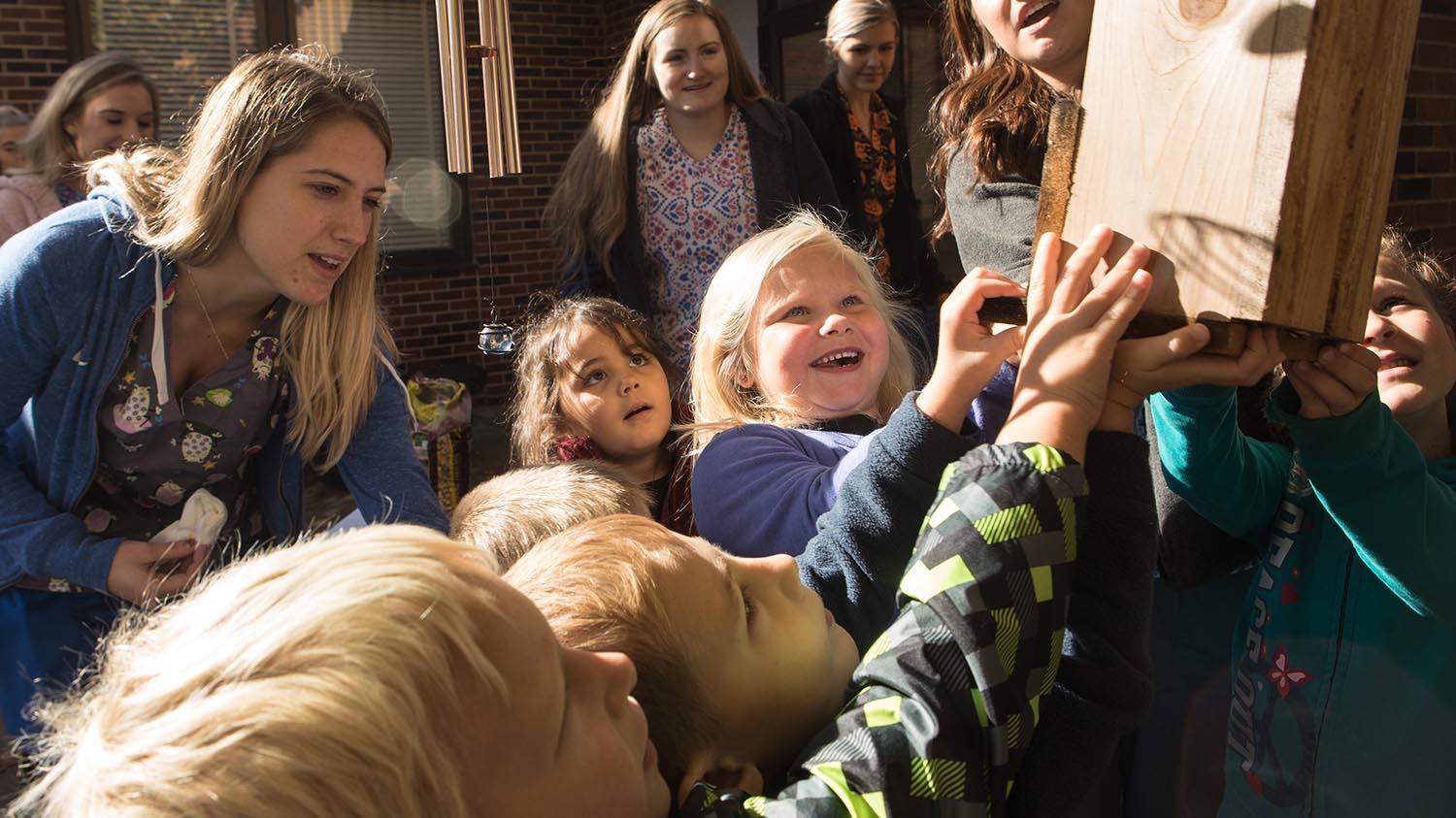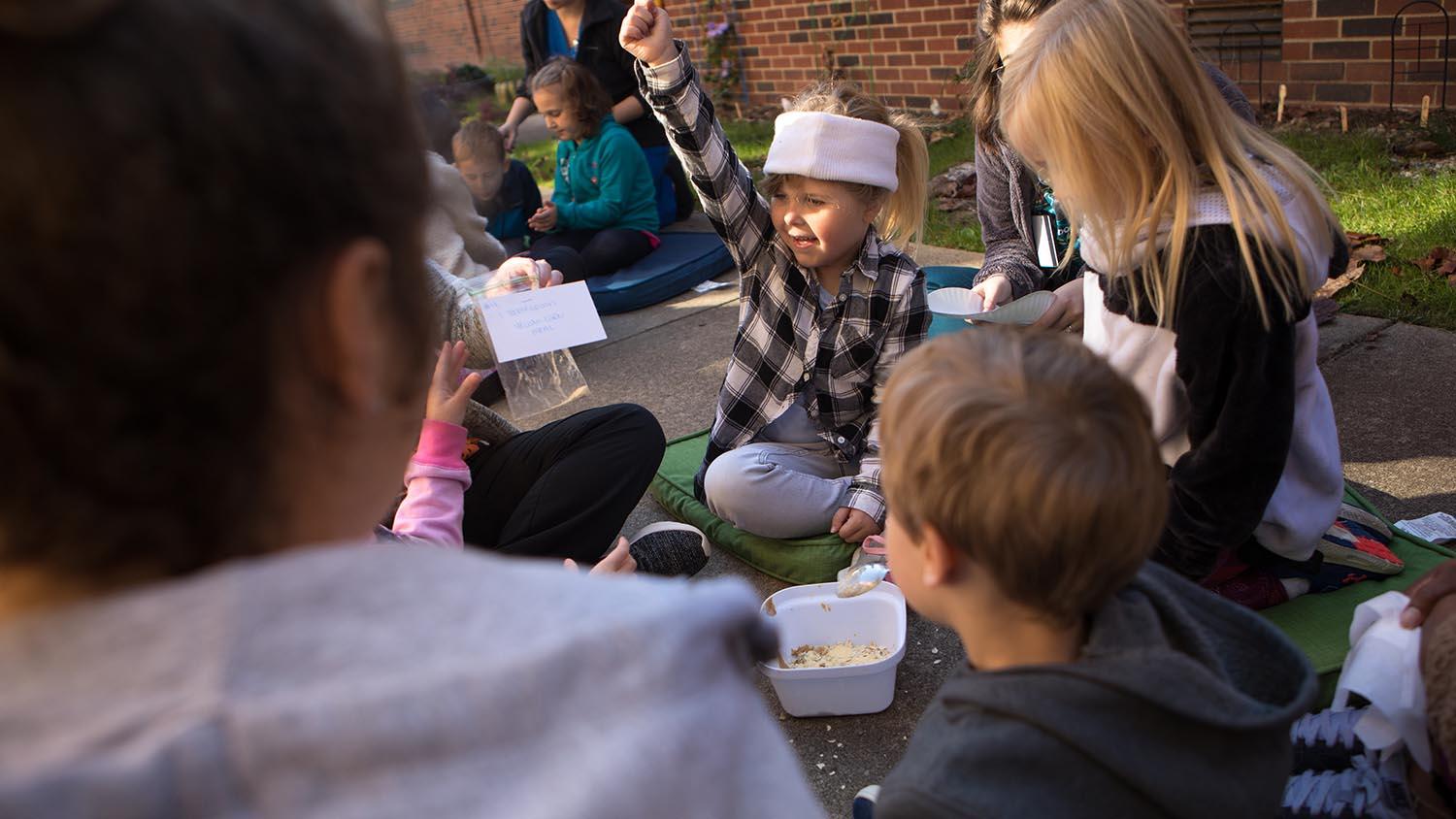Cal U's Learning and Language Center preschool program uses a new sensory garden to enhance the children's development. The garden is an interdisciplinary collaboration between the departments of Communication Disorders and Biological and Environmental Sciences.
When you’re 4 years old, words like “vegetation” and “nutrition” are B-I-G.
“Those are some big words,” acknowledges Dr. Denise Joseph, an associate professor and director of Cal U’s Learning and Language Center in the Communication Disorders Department. “But it’s all part of their vocabulary development as they get ready for kindergarten.”
As part of a “Pennsylvania habitats” lesson, 13 children in the center’s preschool program and their teachers — Cal U students majoring in communication disorders — spent a fine October day learning about squirrels. At the same time, they focused on important speech and language objectives like sequencing, following one- and two-step verbal directions, and increasing vocabulary.
And then the fun part: Jackets on, out they flowed from their classroom to a garden located just outside their Morgan Hall classroom, where they got to fill feeders with squirrel-friendly food and make squirrel-food cookies.
“They loved working with the peanut butter,” says graduate student Camryn Dugan, who led the lesson.
A sensory experience
The outside spot is known as a sensory garden, a collection of plants and materials that stimulate seeing, hearing, smelling, touching and tasting.
A sensory garden can be enjoyed by anyone who simply wants to relax, but it is especially wonder-inspiring for children, whether their development is typical or delayed.
Cal U’s garden was developed in a cross-disciplinary collaboration led by Joseph, associate professor and director of the Learning and Language Center, and Dr. Sarah Meiss, associate professor of biology.
The two received a $5,000 grant from the Faculty Professional Development Committee at Cal U to get the garden growing, with an emphasis on plants and structures that encourage learning and play.
Joseph and Meiss met at Cal U, but came up with the idea of a sensory garden while both were attending classes at Phipps Conservatory and Botanical Gardens for Master Gardener certification. The sensory garden seemed like a perfect project to meet two objectives, improving interdisciplinary collaboration and providing the children with a unique environment for hands-on learning experiences.
“Dr. Joseph and I met often to figure out what we wanted in the garden,” Meiss says. “She wanted plants with color and texture. We also wanted perennials and ways to grow vegetables in the winter so the children could use the garden year 'round. She tells me what she’d like to have to achieve goals and objectives outlined in the curriculum, and then I make designs and suggestions about what will work.”
The University’s sensory garden includes an educational space; a pollinator garden loved by bees and butterflies; an art station that highlights the rainbow of plant colors; plants of different tastes, textures and smells; a sensory walkway with stones that all feel different under little feet; and a music space with wind chimes and plastic pipes that make beautiful noises.
Students in Cal U’s Sustainability Club pitched in, spreading soil and planting beds. Selecting and planting flowers, painting creative planters, placing decorative rocks, and making the best use of the natural outdoor space are just some of the projects that are always underway.
Integrated approach
Each semester 32 graduate students and about 30 undergraduates studying to become speech-language pathologists complete a practicum in the Learning and Language Center. The preschool program enrolls 14 children each academic year. They may be developing normally or have speech or language issues related to a variety of disorders.
The preschool program is a laboratory school for Cal U students who are training to be speech-language pathologists. One of the objectives is to learn strategies to integrate Pennsylvania Common Core State Standards, including Scientific Thinking and Technology, into their classroom interventions.
“Integrating skill areas outside of their traditional scope of practice presents challenges, creating the critical need for speech-language pathology students to develop skills to work collaboratively with professionals in other disciplines in unrelated specialty areas,” Meiss and Joseph wrote in their grant proposal.
The sensory garden is the perfect place to enhance children’s education, development and social interaction and also address the core curriculum standards.
“We want Cal U students to know that they can take an integrated approach with a discipline other than theirs, like a science class, and still be an effective speech therapist,” Joseph says.
“The activity with the squirrel feeders involves following directions and sequencing. Those are speech and language goals that also mesh with the biology lesson. This garden helps to prepare our students for situations when speech therapy happens in an integrated classroom setting.”
Dugan agrees.
“It’s very important for speech-language pathologists to be educated in all the fields,” she says. “We introduced the word ‘vegetarian’ — that’s a big word. When we went outside for the activity, they didn’t say the word exactly right, but they definitely had the concept of what it means. That was awesome! That’s exactly how speech and language concepts can be integrated.”
“It’s a great reinforcement to the lesson,” says Megan Teres, a graduate assistant in communication disorders. “Children love hands-on activities, and as speech-language therapists we always try to incorporate all aspects of learning.”


